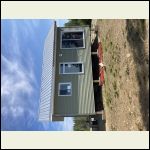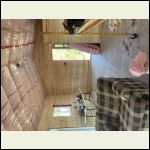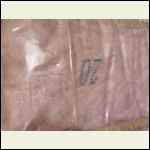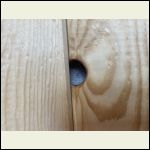|
| Author |
Message |
Princelake
Member
|
# Posted: 6 Sep 2022 04:36pm
Reply
Last year I got my cabin framed roof, windows in weather closed.
This year I wired it, insulated/vapour barrier, pine on most of the walls, and siding on everything but the gables.
Up in northern Ontario the temperature changes have been extreme from plus 2 at night to plus 27 during the day. Yesterday afternoon I noticed moisture on the insulation side of the vapour barrier. Then started investigating and found moisture behind the vapour barrier behind my t&g pine. I ripped down my freshly down pine on 2 of my walls full of water on the vapour barrier!
Why is this happening?!?!?!
2x6 construction r20 walls r40 ceiling with 6mm vapour, house wrap and vinyl siding
142E514FB5CF433FA.jpeg
| 
F68E551E6F6349D7B.jpeg
| 
E6B64EFD69B64FFBB.jpeg
| 
61A065AC146A430DA.jpeg
|
|
|
snobdds
Member
|
# Posted: 6 Sep 2022 05:16pm
Reply
You should have no water in the walls. The water is not coming from the inside, but the outside. Vapor is making it through from the outside somehow.
How are you venting the roof? I don't see soffit venting.
Did you somehow have your roof and walls linked by some framing penetrations?
|
|
Princelake
Member
|
# Posted: 6 Sep 2022 05:55pm
Reply
I have no moisture issues on the ceiling insulation/vapour barrier. I have attic vents(moore vents) with vinyl soffit. I used the foam closers on the metal roofing. When I install the siding on gables I was going to cut out gable vents. I have continues vapour barrier to the floor. I have not insulated the floor yet. My ground underneath is rock.
|
|
snobdds
Member
|
# Posted: 6 Sep 2022 06:35pm
Reply
Time for a smoke test to see where the leak is.
Close off all windows and doors and seal a fan to a doorway to blow out. Take a smoke tester and go around and see where the smoke starts to drift towards the fan. Then investigate.
It's probably around electrical boxes or some other penetration.
|
|
Princelake
Member
|
# Posted: 6 Sep 2022 06:53pm
Reply
I put in the plastic boxes with the foam seals. Moisture is in wall cavities without electrical boxes.
|
|
snobdds
Member
|
# Posted: 6 Sep 2022 07:25pm
Reply
well you're compromised somewhere...
|
|
spencerin
Member
|
# Posted: 6 Sep 2022 10:40pm - Edited by: spencerin
Reply
So, all cavities in 2 walls filled with moisture? Not a random cavity here and there? If that's the case, did you fully insulate those 2 walls all on the same day/at the same time?
|
|
FishHog
Member
|
# Posted: 7 Sep 2022 06:26am
Reply
Was the wood still wet during construction? Might just be coming from there
|
|
|
Princelake
Member
|
# Posted: 7 Sep 2022 06:26am
Reply
I insulated the walls and v.p one day then the next day I insulated and v.p the ceiling. The day after I started the pine on the 2 walls that have the moisture issues. I went back a week later to install the pine on the other 2 walls.
The 2 affected walls do get the sun/heat first thing in the morning. The other walls get the late day sun. I’m wondering if that has anything to do with it
|
|
Aklogcabin
Member
|
# Posted: 7 Sep 2022 08:36am
Reply
Do you have tyvex on your outer walls ?
|
|
Whiskerbiscuit
Member
|
# Posted: 7 Sep 2022 12:39pm
Reply
I've got something similar happening in my cabin, but it only occurs during very specific conditions during late spring or early fall - I have one wall which gets full sun all morning, and if it's cold inside the cabin (I generally only heat it from October-April) and that outside wall is cookin' hot by mid-morning, I do sometimes see a small amount of condensation forming underneath the vapour barrier in that south wall where I haven't installed any interior panelling yet.
However by the end of the day when the interior temperature rises the moisture dissipates, and it never occurs in the winter (when the inside of the cabin is warmer than outside).
It is usually recommended that the vapour barrier is supposed to go on the "warm" side of the insulation - which for Canada is the inside....but places like Florida where the outside is hot and humid and the constant AC use makes the inside cold and dry - the vapour barrier is more often on the outside. So is it possible it is just the temperature difference that is causing the moisture to travel inwards? I'd be curious to know if you were having the same issues when the daytime temperatures drop 15 degrees.
|
|
Princelake
Member
|
# Posted: 7 Sep 2022 01:19pm
Reply
I framed it last summer so it sat for a year drying out. I have typar with vinyl siding.
Whisker biscuit I think yours is the most sense but how does that get corrected other then to forget it and hope it dries?
My boss is an engineer he believes i must have trapped moisture when i vapour barrier it like a high humidity day. He recommends baking the place with electric heaters or indirect propane heaters for a couple days and put the vapour barrier on hot and acoustical seal every joint
|
|
Nate R
Member
|
# Posted: 7 Sep 2022 02:12pm
Reply
Princelake: It's not trapped in there if you have wood sheathing and tyvek. It would take time, but could certainly work its way out..and would dry out over time. Wood sheathing is a vapor retarder, but not a barrier...water vapor can and will find its way through it and outside.
Guessing that you have some solar vapor drive going on, and I think WhiskerBiscuit is on point...the temp swings (and thus RH) swings probably contribute to making it worse right now...
|
|
Whiskerbiscuit
Member
|
# Posted: 7 Sep 2022 04:44pm
Reply
I was a bit concerned when I first noticed it, but in my case it seems to be a very temporary condition - usually signs of moisture are gone later in the same day it appears once the temps equalize. My wall structure goes (from inside outwards) 1/4" pine siding > vapour barrier > insulation > 1/2" plywood > black asphalt building paper > 1/2" air gap > vertical metal siding.
The fact that there's no floor insulation right now in yours may be adding to the temperature difference between night and day.
I don't really know what the best practice would be if you are going to leave the cabin unoccupied and sealed up for long periods of time if it's not in year round use, but some of the other members on here might have some advice.
|
|
spencerin
Member
|
# Posted: 7 Sep 2022 06:04pm
Reply
I was thinking along similar lines, that moist air got trapped in the cavities when insulated, and maybe your construction is so tight that it can't escape. When exactly did you insulate those walls? I can see a scenario where it was done when it was cold outside and you're inside burning a vent-free propane heater to keep warm, which puts a ton of moisture in the air.
What your boss suggested as a solution makes sense, worth a shot if it's not too much trouble.
|
|
Princelake
Member
|
# Posted: 7 Sep 2022 10:16pm
Reply
I insulated it beginning of July no heat on. Thinking back I took the week off and it wasn’t the best weather.
I think I’m going to do what my boss says it’s not a huge trouble grabbing an extra Genny from work and some heaters maybe even a dehu. Burn a good 5-10 gallon of gas run 2 generators bake the place and install the vapour barrier and move on with my life.
|
|
Nate R
Member
|
# Posted: 8 Sep 2022 08:50am
Reply
Really a waste of time and energy, in my opinion. You're better off spending 2 hours reading up about water vapor transmission through building materials, perm ratings, and solar vapor drive...
https://www.buildingscience.com/documents/insights/bsi-038-mind-the-gap-eh
|
|
gcrank1
Member
|
# Posted: 8 Sep 2022 10:43am
Reply
Really good article Nate!
We need to have that 'sticky'ed' or something for easy future ref.
|
|
Nate R
Member
|
# Posted: 8 Sep 2022 11:27am
Reply
Quoting: gcrank1 Really good article Nate! We need to have that 'sticky'ed' or something for easy future ref.
Thanks! Hard to pick just one from BSC, there's TONS of good info on that site, much of it free to read and take in. A great resource to learn some building science, and what to care about.
-Nate
|
|
BRADISH
Member
|
# Posted: 13 Sep 2022 01:51pm
Reply
Quoting: Whiskerbiscuit I've got something similar happening in my cabin, but it only occurs during very specific conditions during late spring or early fall - I have one wall which gets full sun all morning, and if it's cold inside the cabin (I generally only heat it from October-April) and that outside wall is cookin' hot by mid-morning, I do sometimes see a small amount of condensation forming underneath the vapour barrier in that south wall where I haven't installed any interior panelling yet.
I believe I am having this exact issue on my new build as well. Thanks for making me believe I'm not crazy.
|
|
|

